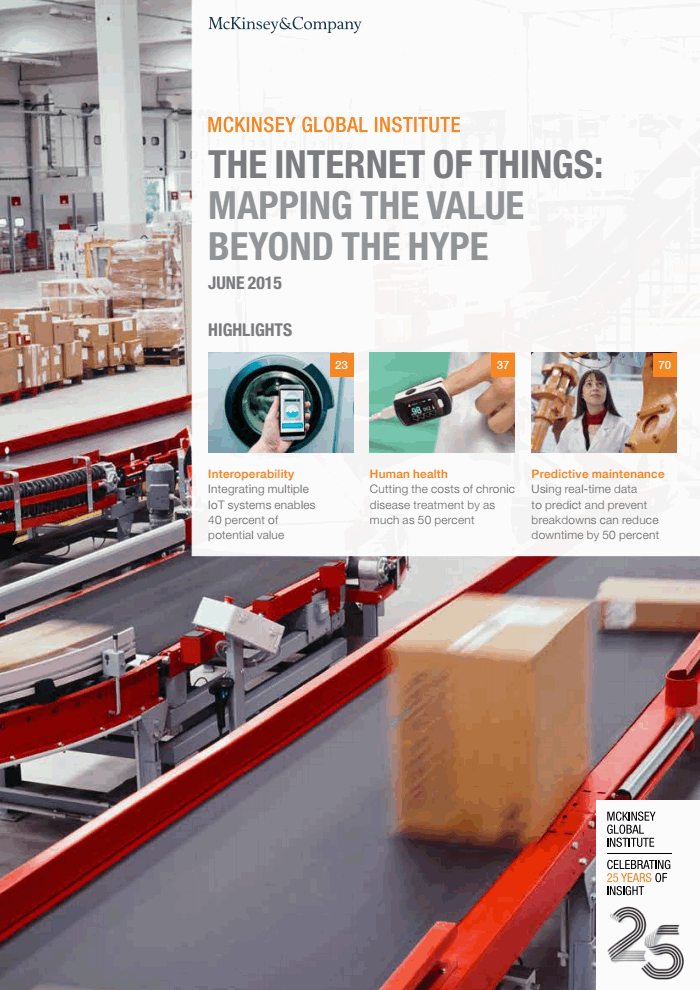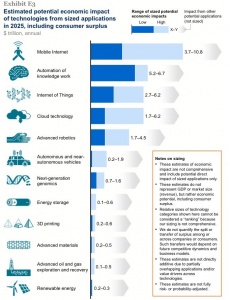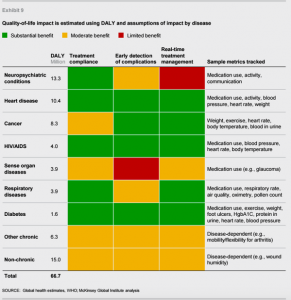 ‘Tis the summer of big, smart reports covering the Internet of Things (IoT) impact on health and fitness. Just this month, three of these missives have come to my inbox, and they all contribute sound thinking about the topic. Today, tomorrow and Friday, I’ll cover each of these here in Health Populi. We begin with McKinsey Global Institute’s The Internet of Things: Mapping the Value Beyond the Hype.
‘Tis the summer of big, smart reports covering the Internet of Things (IoT) impact on health and fitness. Just this month, three of these missives have come to my inbox, and they all contribute sound thinking about the topic. Today, tomorrow and Friday, I’ll cover each of these here in Health Populi. We begin with McKinsey Global Institute’s The Internet of Things: Mapping the Value Beyond the Hype.
[In full disclosure, I was an outside adviser to the MGI team members who focused on the human/health and fitness aspects of this report, and thank MGI for the opportunity to provide input into their research].
MGI points to 9 settings where IoT can create value: Home (e.g., security, chore automation), Offices (energy, security), Factories (operations, optimization of capital equipment), Retail (e.g., automated checkout), Worksites (health and safety), Human (health and fitness), Outside (logistics, navigation), Cities (public health, transport), and Vehicles (think: connected car, autonomous vehicles).
In each of these opportunity areas, data created through Internet connections can be captured and analyzed for predictions and optimization of business workflow and consumer “life-flow.” In total, MGI forecasts a total cross-sector value across the 9 settings ranging from $3.9 trillion to $11.1 trillion per year in 2025.
 IoT in the Human (health/fitness) setting is described by MGI as “devices attached to or inside the human body,” where MGI says, “people will use to guide their actions and decisions.” Based on this definition, value created by IoT in the Human segment could reach $1.6 trillion globally, MGI calculates.
IoT in the Human (health/fitness) setting is described by MGI as “devices attached to or inside the human body,” where MGI says, “people will use to guide their actions and decisions.” Based on this definition, value created by IoT in the Human segment could reach $1.6 trillion globally, MGI calculates.
To put this number in context, the U.S. spends about $3 trillion a year on health care: that is, the proportion of spending on healthcare in the U.S. national health expenditure accounts, what gets counted in the GDP and comprises about 17% of the U.S. economy, compared with about 9% for OECD countries.
The $1.6 trillion value arises through monitoring and treating illness, and improving wellness (say, through nudging people toward lifestyle behaviors like healthier eating and taking more exercise) — enhancing peoples’ quality of life, extending healthy life spans for people with chronic conditions, and reducing the direct costs of treatments. In the report, MGI segments health conditions by IoT impact including treatment compliance, early detection of complications, and real-time treatment management to understand the various levels of benefits for each condition. The greatest “DALYs,” disability adjusted life-years, accrue among patients dealing with neuropsychiatric conditions, heart disease, cancer, HIV/AIDS, sense organ diseases, and respiratory diseases, based on MGI’s calculations.
 Health Populi’s Hot Points: The opportunity for IoT to positively impact health care costs in the U.S. — to help bend the cost curve — is tremendous. But MGI rightly points out a major barrier to getting to this cost-cutting Nirvana: lack of interoperability. MGI notes that interoperability is required to capture 40% of the total values of IoT across all settings. In healthcare, this may be an even larger challenge than for other industry sectors with less complicated data sets, such as banking and energy.
Health Populi’s Hot Points: The opportunity for IoT to positively impact health care costs in the U.S. — to help bend the cost curve — is tremendous. But MGI rightly points out a major barrier to getting to this cost-cutting Nirvana: lack of interoperability. MGI notes that interoperability is required to capture 40% of the total values of IoT across all settings. In healthcare, this may be an even larger challenge than for other industry sectors with less complicated data sets, such as banking and energy.
In healthcare, we talk about “interoperability” in the context of the HITECH Act, Meaningful Use, and implementation of electronic health records in provider settings. In the IoT world, the concept extends to even more hardware, both in provider settings like remote health monitoring equipment, along with home-based equipment and mobile/wearable sensors. With the likes of Validic and other newer entrants focusing on the “API-ification” of health data integration, we’re on the road to reducing the friction between Big Iron EHRs and Todd Park’s vision of Data Liberación. Furthermore, exciting developments with FHIR and “appification” within the EHR environment via Dr. Ken Mandl’s work is encouraging and moving us toward better data liquidity.
Furthermore, it’s the context for adopting IoT in health that’s also very important to getting to the value. “Perhaps more challenging than the technical issues are the structure changes necessary to create incentives for behavior changes among health-care payors, providers, and patients,” MGI notes. Behavior change is hard without aligning incentives, and the perceptions and values of incentives for each of these stakeholder groups are quite different.
On the value-calculation, as a health economist and someone who does cost-effectiveness and cost-benefit analyses in my daily work, I would point out other hard-currency values that can be generated through the IoT Human channel. Patients’ return-to-work, as wage earners and taxpayers, is a direct quantifiable benefit, for example, to add to the $1.6 trillion. Further spin-off impacts of those workers patronizing businesses in their local communities — including patronizing neighborhood restaurants, flower shops, dry cleaners, et. al. — are additional positive adds to the value of IoT in health as more health citizens contribute to the economy for more life-years.
Visit Health Populi on Thursday 9th July and Friday 10th July to read our take on two more IoT/health reports – from Goldman Sachs and Accenture.




 I'm in amazing company here with other #digitalhealth innovators, thinkers and doers. Thank you to Cristian Cortez Fernandez and Zallud for this recognition; I'm grateful.
I'm in amazing company here with other #digitalhealth innovators, thinkers and doers. Thank you to Cristian Cortez Fernandez and Zallud for this recognition; I'm grateful. Jane was named as a member of the AHIP 2024 Advisory Board, joining some valued colleagues to prepare for the challenges and opportunities facing health plans, systems, and other industry stakeholders.
Jane was named as a member of the AHIP 2024 Advisory Board, joining some valued colleagues to prepare for the challenges and opportunities facing health plans, systems, and other industry stakeholders.  Join Jane at AHIP's annual meeting in Las Vegas: I'll be speaking, moderating a panel, and providing thought leadership on health consumers and bolstering equity, empowerment, and self-care.
Join Jane at AHIP's annual meeting in Las Vegas: I'll be speaking, moderating a panel, and providing thought leadership on health consumers and bolstering equity, empowerment, and self-care.